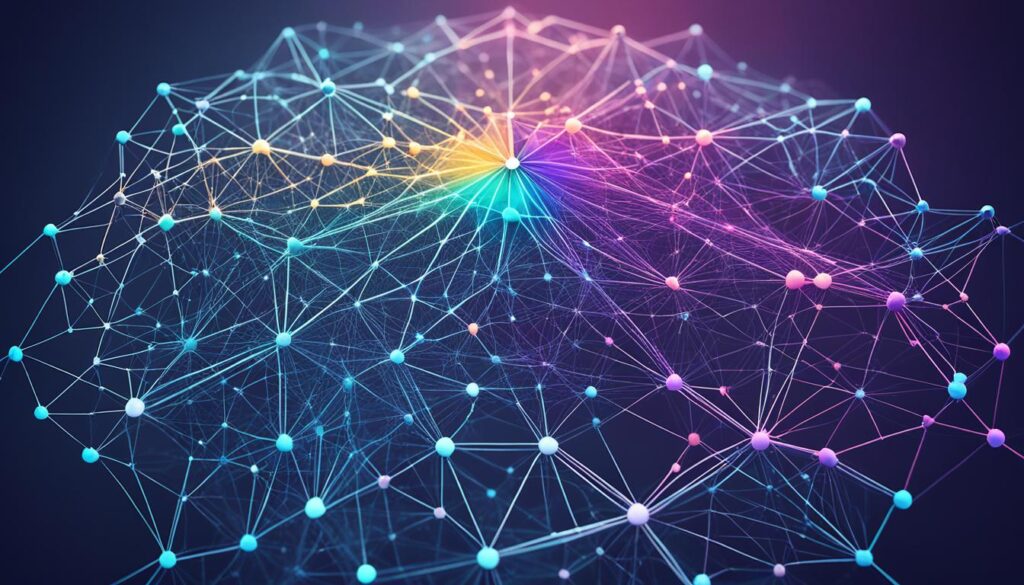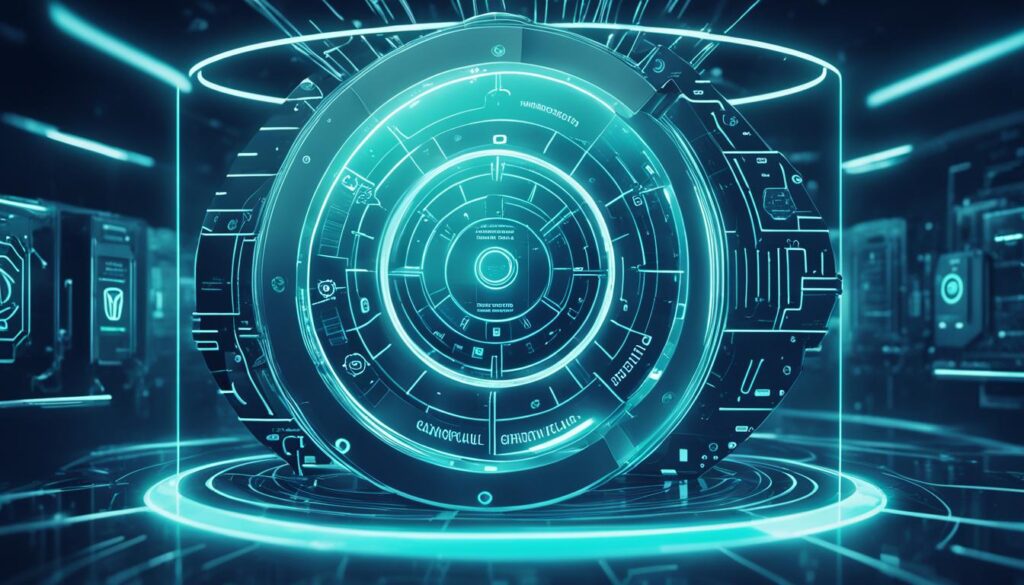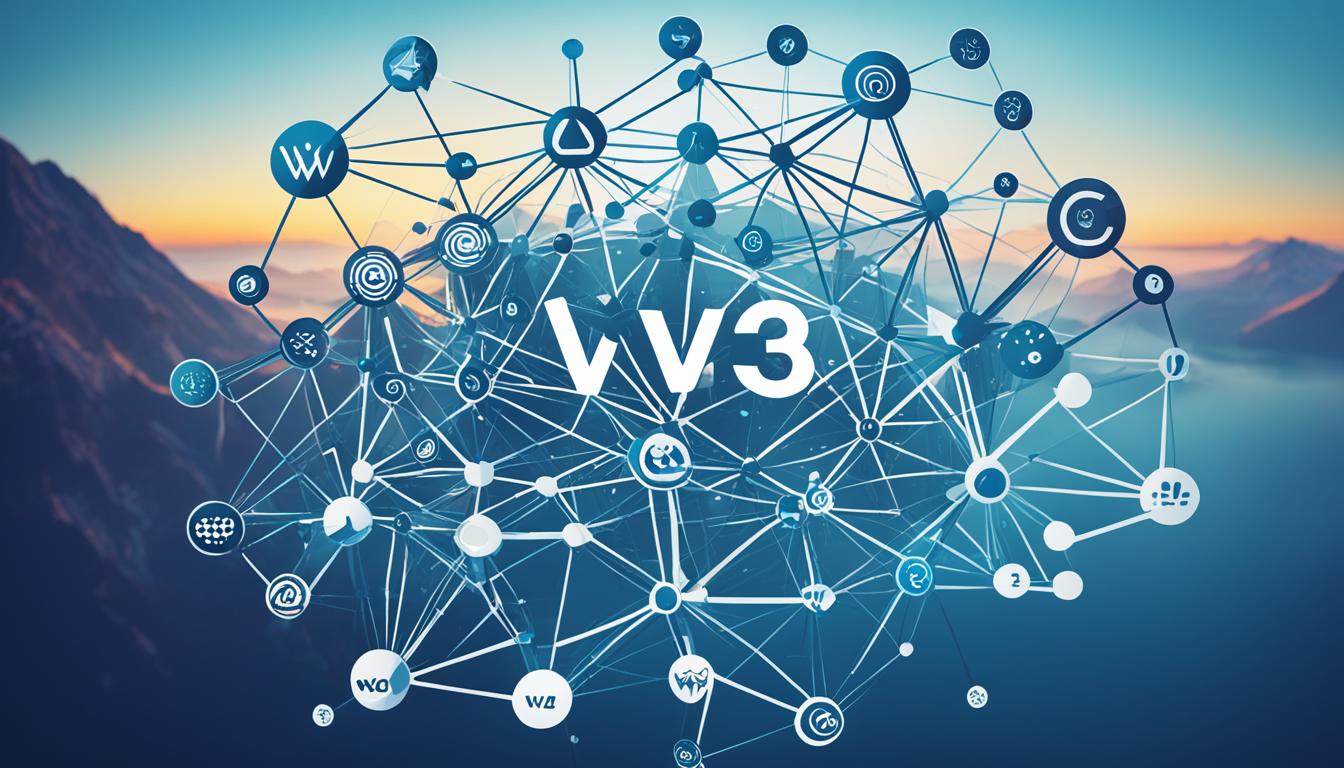Welcome to the era of Web 3.0 and decentralized identity, where users are taking control of their online presence like never before. With the rapid evolution of technology, Web3 offers a new paradigm that prioritizes user empowerment, data ownership, and enhanced privacy and security. This article explores the exciting possibilities of Web3 technology, the concept of decentralized identity, and how it is reshaping the digital landscape.
Key Takeaways:
- Web3 technology empowers users with greater control over their personal information.
- Decentralized identity allows individuals to own and manage their digital identities.
- Data ownership ensures individuals have complete control over their personal data.
- Web3 prioritizes user empowerment, privacy, and data security.
- Decentralized identity and Web3 are reshaping the future of the internet.
Understanding Web3
Web3, also known as the decentralized web, is revolutionizing the digital landscape by leveraging blockchain technology, cryptography, and decentralized networks. This new paradigm prioritizes user sovereignty, privacy, and security, marking a distinct shift from the centralized intermediaries of Web2.
Through Web3, users gain greater control over their digital identities and personal data, eliminating the need for trusted third parties. By distributing authority and control across the network, Web3 fosters trust, transparency, and resilience in the digital ecosystem.
“Web3 is transforming the internet into a user-centric and secure platform, empowering individuals to take charge of their online presence.” – Web3 Enthusiast
How Web3 Works
Web3 operates on the principles of decentralization, ensuring that power is distributed throughout the network rather than concentrated in the hands of a few entities. This decentralized approach fosters trust and transparency, as no single entity has control over the entire system.
Blockchain technology is at the core of Web3, providing a tamper-proof and immutable ledger that secures and verifies transactions and data. Cryptography ensures that communications and data transfers are encrypted, protecting user privacy and enhancing security.
Decentralized networks create a resilient and fault-tolerant infrastructure that is resistant to censorship and single-point failures. By removing the reliance on a single server, Web3 enhances security and ensures uninterrupted access to services.

The Benefits of Web3
Web3 offers a range of benefits for users and businesses alike:
- User Sovereignty: With Web3, users have complete control over their personal data and digital identities, empowering them with the freedom to choose how and when to share their information online.
- Enhanced Privacy: Web3 prioritizes user privacy by leveraging cryptographic protocols to protect sensitive data and transactions.
- Improved Security: By eliminating centralized intermediaries, Web3 reduces the risk of data breaches and unauthorized access, creating a more secure digital environment.
- Trust and Transparency: The decentralized nature of Web3 fosters trust by ensuring that transactions and data are verifiable and transparent, enhancing the overall integrity of the system.
| Benefits of Web3 | User Sovereignty | Enhanced Privacy | Improved Security | Trust and Transparency |
|---|---|---|---|---|
| Web3 | ✔️ | ✔️ | ✔️ | ✔️ |
| Web2 | ❌ | ❌ | ❌ | ❌ |
With the increasing adoption of Web3 technologies, users can look forward to a more user-centric and secure internet experience, where their privacy and security are prioritized. Businesses that embrace Web3 can benefit from enhanced trust, transparency, and the ability to provide greater value to their users.
The Key Principles of Web3
Web3 operates on key principles that revolutionize the digital landscape and empower users. These principles include decentralization, data ownership, user control, transparency, trust, resilience, and a user-centric approach. Let’s delve into each of these principles and explore their significance in shaping the future of the internet.
Decentralization
In Web3, decentralization is a fundamental principle that ensures power is not concentrated in the hands of a few centralized intermediaries. By distributing authority across a network, Web3 enhances transparency, trust, and resilience. It lays the foundation for a more democratic and inclusive digital ecosystem.
Data Ownership
Web3 gives individuals complete control over their personal data. With data ownership, users have the right to determine how their information is used, shared, and stored. This principle provides autonomy, privacy, and security, placing the control of personal information in the hands of the rightful owners.
User Control
A user-centric approach is at the heart of Web3. User control empowers individuals to manage their digital identities and personal information according to their preferences. Users have the agency to determine what data they disclose and to whom, allowing them to maintain their privacy and exercise control over their online presence.
Transparency
Transparency is a key principle of Web3 that fosters trust and accountability. By providing visibility into the inner workings of systems and processes, Web3 ensures that users can verify the integrity and fairness of digital interactions. Transparent systems promote openness and enable users to make informed decisions.
Trust
Trust is essential in the digital world, and Web3 seeks to establish trust by design. Through decentralized networks and cryptographic protocols, Web3 minimizes the reliance on trusted third parties, creating a more trustworthy environment. Trust is further enhanced by the transparency and user control supported by the Web3 framework.
Resilience
Resilience is a core principle of Web3 that aims to build systems capable of withstanding disruptions and attacks. By decentralizing data and authority, Web3 reduces vulnerabilities and ensures that failures in one part of the network do not compromise the entire system. Resilience enables continuity and sustainability in the face of challenges.
User-Centric Approach
Web3 puts users first. It revolves around the individual’s needs, preferences, and empowerment. A user-centric approach prioritizes privacy, security, and user experience, creating a digital environment where users have agency and can shape their online interactions according to their values and desires.

Decentralization, data ownership, user control, transparency, trust, resilience, and a user-centric approach are the foundational principles of Web3. These principles challenge the status quo, revolutionizing the digital landscape and giving users greater control over their online interactions. To fully understand the impact of Web3, let’s explore the current state of digital identity in the next section.
The Current State of Digital Identity
In the context of Web3, digital identity undergoes a significant transformation through the concept of self-sovereign identity (SSI). SSI empowers individuals by granting them complete control and ownership over their personal data and digital identities. Users have the freedom to securely store their data and selectively disclose it as needed. This user-centric approach prioritizes privacy, verification, and authentication, ensuring that individuals have full control over their digital identities and personal information.
Self-sovereign identity (SSI) is a revolutionary concept that puts individuals back in control of their own digital lives. It is a direct response to the growing concerns around privacy and data security in the age of the internet. With SSI, individuals no longer have to rely on third-party intermediaries to manage and verify their identities. Instead, they have the power to manage and control their own personal data, determining what information they share and with whom.
One of the key aspects of SSI is secure storage. Users can store their personal data in a secure and encrypted manner, ensuring that it is protected from unauthorized access. This not only enhances privacy but also reduces the risk of data breaches and identity theft.
Additionally, SSI enables selective disclosure, allowing individuals to choose what information they reveal in different contexts. For example, when signing up for a service that requires age verification, users can disclose only their age without revealing other personal details.
“Self-sovereign identity puts individuals in control of their own digital destiny. It is a game-changer in terms of privacy, security, and personal empowerment.” – Sarah Johnson, Privacy Advocate
SSI also prioritizes verification and authentication. With SSI, individuals can prove their identity and authenticate credentials without relying on centralized authorities. This not only streamlines processes but also eliminates the need for individuals to repeatedly share sensitive information.
Overall, the current state of digital identity is evolving towards a user-centric model where individuals have full control over their personal data and digital identities. The concept of self-sovereign identity (SSI) empowers individuals, ensuring that they have complete ownership, privacy, secure storage, selective disclosure, verification, and authentication of their digital identities.

Decentralized Identity and Blockchain Technology
Decentralized identity is revolutionizing the way we store and manage identity information, leveraging the power of blockchain technology and distributed ledgers. This innovative approach ensures secure and tamper-proof storage, while also enhancing privacy and verifiability.
The use of blockchain technology provides a distributed and decentralized network, making it virtually impossible for hackers to tamper with the stored data. Each transaction or update recorded on the distributed ledger is cryptographically secured, ensuring the integrity and immutability of the identity information.
One of the key features of decentralized identity is the use of verifiable credentials. These credentials act as digital proofs of identity attributes, such as age, qualifications, or employment history. Verifiable credentials are signed by trusted issuers and can be independently verified, allowing individuals to selectively disclose only the necessary information without compromising their privacy.
Interoperability is another essential aspect of decentralized identity. By using open standards and protocols, decentralized identity solutions can seamlessly integrate with existing systems, providing a unified and efficient identity management experience. This interoperability ensures that individuals can use their decentralized identities across multiple platforms and services, without the need to create and maintain separate accounts or profiles for each.
Furthermore, privacy-enhancing technologies play a crucial role in decentralized identity systems. Techniques such as zero-knowledge proofs and attribute-based encryption enable individuals to protect their sensitive information while still proving its validity in a secure manner. These privacy-enhancing technologies strike a balance between data privacy and data utility, offering individuals greater control over their personal information.
Decentralized identity and blockchain technology are at the forefront of the digital revolution, providing a robust and secure infrastructure for managing identities. With tamper-proof storage, verifiable credentials, interoperability, and privacy-enhancing technologies, decentralized identity is shaping the future of identity management, empowering individuals with control over their own digital identities and ensuring enhanced privacy and security.
Benefits of Web3 and Decentralized Identity
Web3 and decentralized identity offer a wide range of benefits, revolutionizing the digital landscape and empowering individuals. Let’s explore the significant advantages that these technologies bring:
1. Decentralization
Decentralization eliminates the need for central authorities and intermediaries, enhancing trust, security, and privacy. By distributing power across the network, Web3 ensures that no single entity has control over personal data and identities, giving individuals greater autonomy.
2. Empowerment
Decentralized identity systems enable users to have efficient control over their digital identities and personal information. With the ability to manage and selectively share relevant data, individuals regain their sovereignty and retain full ownership of their information.
3. Efficient Credential Verification
Decentralized identity solutions offer streamlined and efficient credential verification processes. Users no longer rely on lengthy and often cumbersome procedures, saving time and resources for both individuals and organizations.
4. Interoperability
Web3’s interoperability allows for seamless integration with existing systems. This compatibility enhances efficiency, enabling individuals to navigate the digital landscape effortlessly. With decentralized identity, users can access various platforms and services with ease.
5. Cost Savings
Businesses can benefit from cost savings with decentralized identity solutions. By eliminating the need for intermediaries and reducing administrative overheads, organizations can optimize their operations and improve their bottom line.
6. Trust, Security, and Privacy
Decentralized identity enhances trust and security by leveraging cryptography and blockchain technology. By removing centralized points of failure, individuals have greater control over their personal data, ensuring privacy and data protection.
7. Enhanced User Privacy
Decentralized identity prioritizes user privacy by allowing individuals to choose which information they share and with whom. This selective disclosure ensures that users maintain control over their personal information, mitigating the risk of data breaches and unauthorized access.
In summary, Web3 and decentralized identity bring undeniable benefits to both individuals and organizations. By embracing the principles of decentralization, trust, security, privacy, and interoperability, these technologies reshape the way we interact with the digital world, empowering individuals and enhancing the overall online experience.
Conclusion
Web3 and decentralized identity are paving the way for a new era of the internet, one that puts users in control. Through Web3 technologies, individuals enjoy greater transparency, security, and empowerment over their digital identities and personal data. The principles of decentralization, data ownership, and user control redefine the relationship between individuals and their digital presence, providing a more user-centric online experience.
The future of the internet lies in the hands of individuals who can now protect their privacy and secure their data through decentralized identity systems. With Web3, users have the ability to decide who has access to their information, ensuring enhanced privacy and mitigating the risks of data breaches. This shift towards user empowerment is crucial in an era where personal data is increasingly valuable.
By integrating Web3 technologies and embracing decentralized identity, businesses can position themselves at the forefront of innovation. Embracing the principles of Web3 not only strengthens trust and security but also enables more efficient credential verification and potential cost savings. Furthermore, the interoperability of Web3 ensures seamless integration with existing systems, creating a more interconnected and user-centric digital ecosystem.
FAQ
What is Web3?
Web3, also known as the decentralized web, leverages blockchain technology, cryptography, and decentralized networks to create a more user-centric and secure internet experience. Unlike Web2, which relies on centralized intermediaries, Web3 emphasizes user sovereignty, privacy, and security.
What are the key principles of Web3?
The key principles of Web3 include decentralization, data ownership, and user control. Decentralization ensures that power is not concentrated in the hands of centralized intermediaries, enhancing transparency, trust, and resilience. Data ownership empowers individuals to have complete control over their personal data, while user control prioritizes user agency in managing their digital identities and personal information.
How does decentralized identity work?
Decentralized identity relies on blockchain technology and distributed ledgers to provide secure and tamper-proof storage of identity information. The use of blockchain ensures the integrity of the stored data, making it resistant to manipulation. Decentralized identity systems use verifiable credentials to authenticate identity attributes, allowing individuals to selectively disclose information while maintaining their privacy.
What are the benefits of Web3 and decentralized identity?
Web3 and decentralized identity offer numerous benefits. Decentralization improves trust, security, and privacy by removing the need for central authorities and intermediaries. Decentralized identity systems enable efficient credential verification, saving time and resources. Businesses can also benefit from cost savings and enhanced security with decentralized identity solutions.
How do Web3 and decentralized identity empower users?
Web3 and decentralized identity empower users by giving them greater control over their digital identities and personal data. Users have the freedom to securely store their data and selectively disclose it as needed. The principles of decentralization, data ownership, and user control redefine the relationship between individuals and their digital identities, prioritizing user empowerment and agency in the online world.








